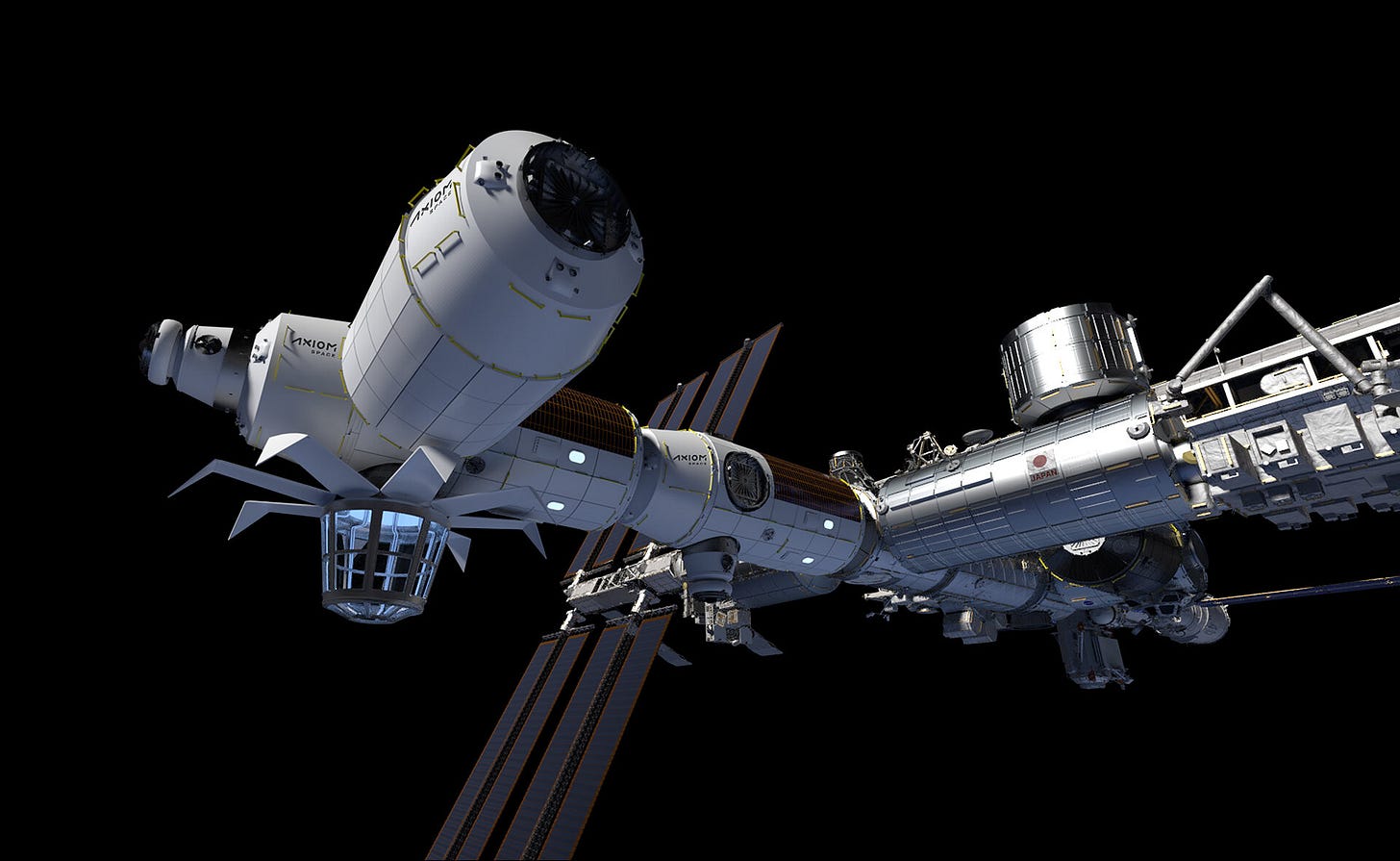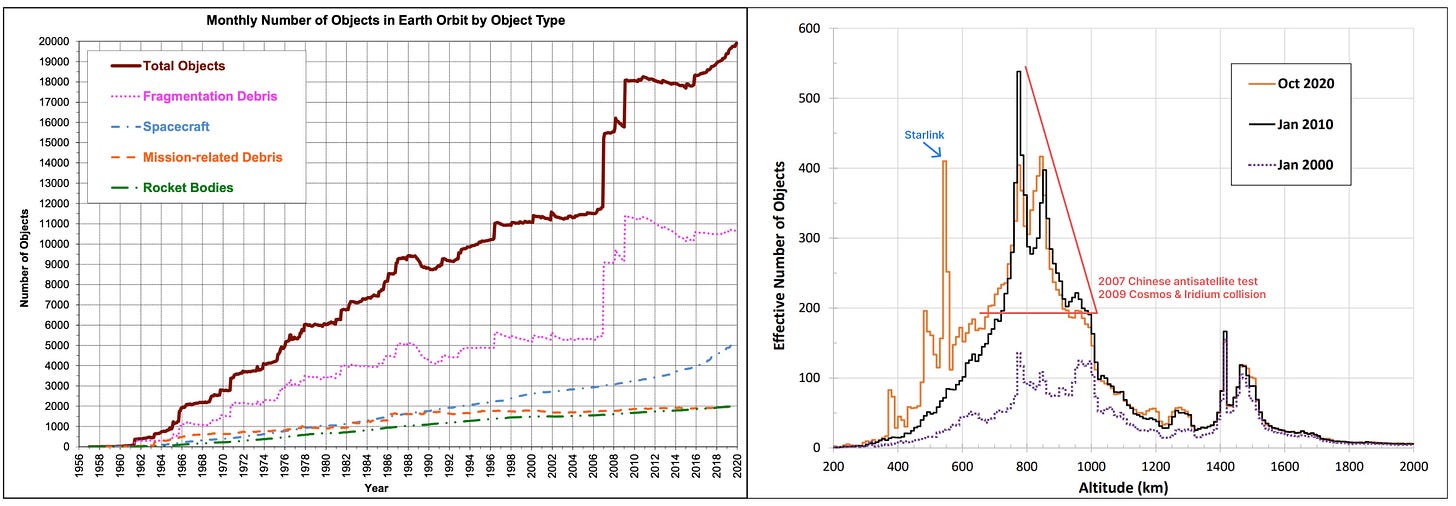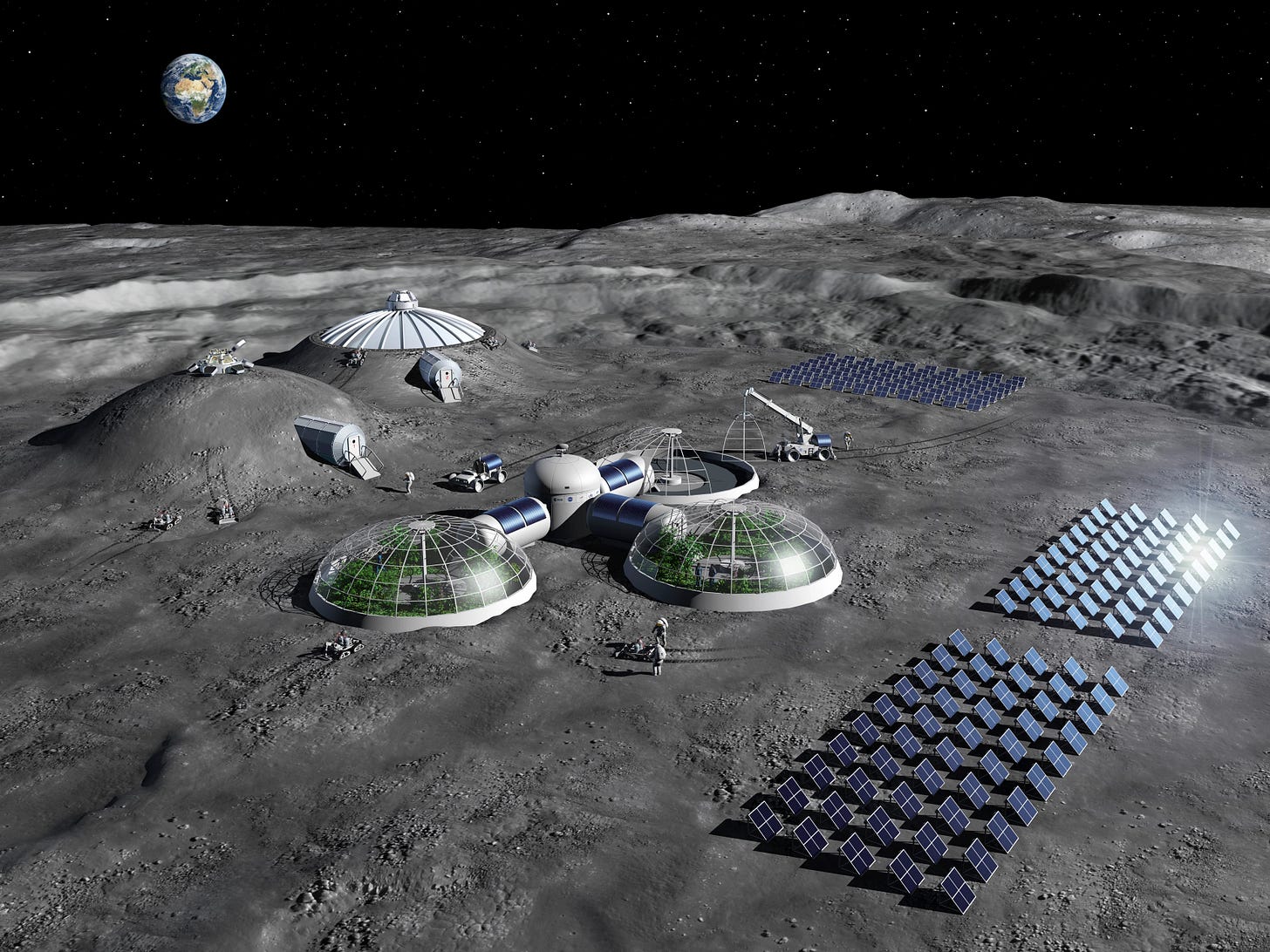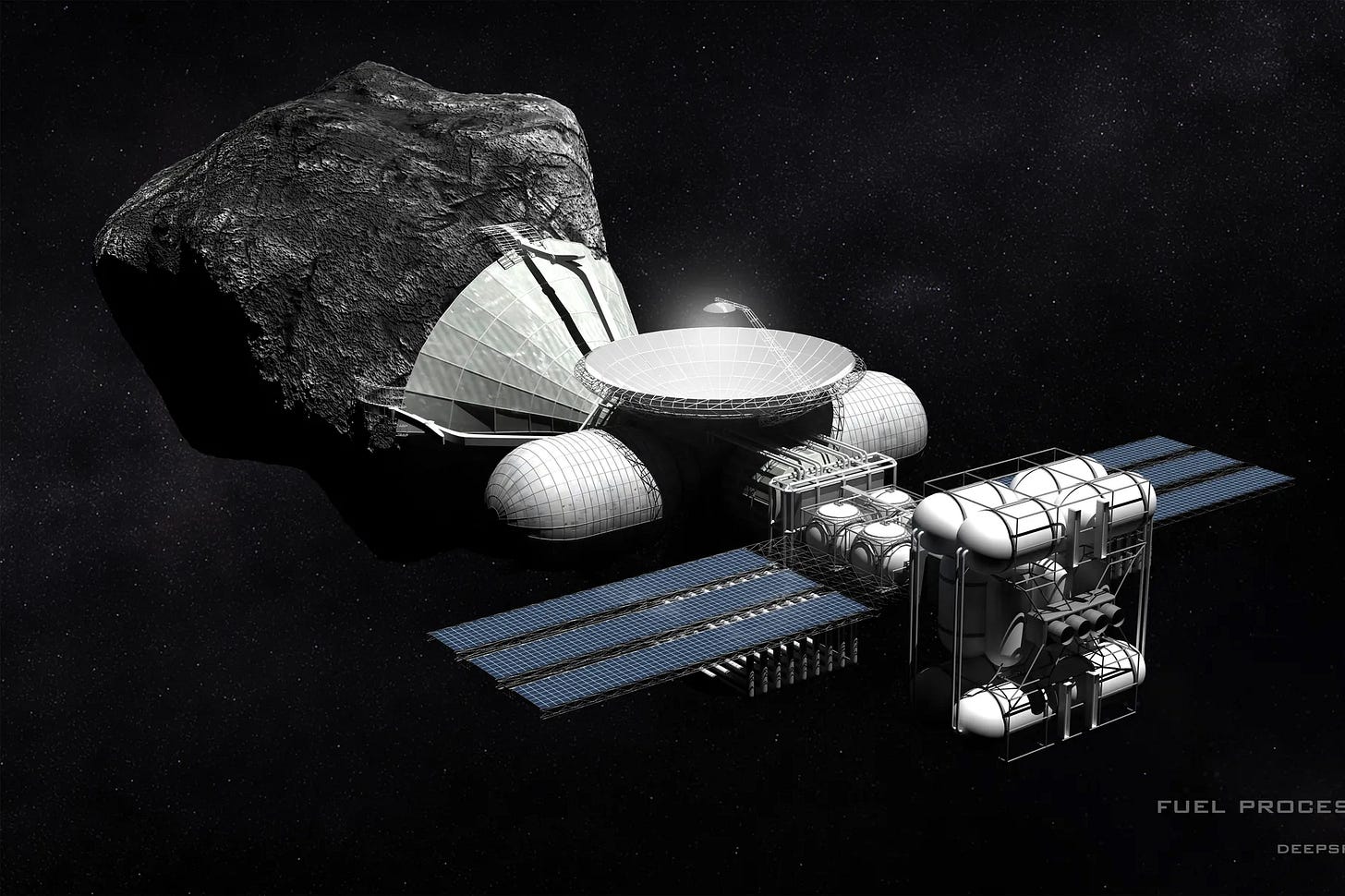The Future of Space, Part II: The Potential
This edition is all about the future of space. But first…
Audio!
I’ve been wanting to explore doing something in the audio/podcasting area for a while now. There’s plenty of good interview-focused shows out there so I didn’t want to go that route. Taking inspiration from Stratechery, I settled on doing an audio version of selected blog posts. It’s just an experiment at this point but I’ve been enjoying the creation of the first few episodes so I’ll see how things go.
The first episode is already up: “The Future of Space, Part I: The Setup”. I’ll follow with the audio version of Part II in the next week.
Now on with the essay.
Getting to space is about to get a lot easier. I reviewed the reasons why in Part I. Now for the fun part: what it will lead to.
A 10x reduction in cost to orbit has already started to change things. The next 10x reduction will lead to outcomes and use cases much harder to comprehend or predict. It would have been hard for anyone in the late 1800s to predict what drastically lower costs of energy and electricity would eventually bring. Or for anyone in the 1970s to predict the consequences of abundant computing power and ubiquitous global communication (Reddit? NFTs? Protein folding?).
But we can try.
This summary is focused on some of the changes we're likely to see in the next 5 to 20 years. A lot can happen in that time frame. For reference, it's taken SpaceX only 19 years to accomplish what they have. But progress compounds and is exponential — especially so once a tipping point like this has been crossed. The change we'll see in the next 20 years will dwarf that of the last 20.
(Quick note: This isn't meant to be comprehensive. It's a highlight of the new areas I find most interesting, and doesn't include anything on the two biggest space segments: communication and Earth observation. Although there are plenty of interesting potentials here — like globally available high-speed internet [Starlink] or ubiquitous, near-real-time worldwide monitoring [Planet].)
Infrastructure
Transportation & Launch Services
The progress of SpaceX, the current leader here, was detailed in Part I. Given the Falcon 9's low costs, it's likely to be the preferred choice for medium-sized payloads, and even smaller payloads with rideshares.
Until now, SpaceX has self-funded their Starship super-heavy launch vehicle. That changed a few weeks ago when NASA announced that Starship had won the contract to land humans on the Moon again. This is huge. The contract will fund $2.9 billion of development costs and speed up the timeline for Starship to become human rated. With the pace of their current development, Starship is on track to become fully operational within 3 years. This should keep SpaceX the leader for heavy and super-heavy launches for some time.
When it comes to delivering humans, the other Commercial Crew competitor, Boeing, is more than a year behind after testing mishaps. Blue Origin may the next best bet for heavy-launch vehicles and a dark horse candidate given its potential funding from Jeff Bezos. There's multiple smaller upstarts like Rocket Lab,Relativity Space or Astra at the low-end of the market, potentially moving disruptively upward. SpaceX blazed the path for these rocket companies, showing how far costs can come down, and proving that lower prices can expand market size.
Also included in this category are spaceports. Most spaceports are currently owned and operated by governments — like Kennedy Space Center at Cape Canaveral, Florida, or Vandenberg Air Force Base in California. This will start to change in tandem with the growth of commercial space.
Spaceport America in New Mexico is an example of an all-commercial spaceport, similar to most airports in that it's owned and operated by the state. Rocket Lab built their own spaceport, Rocket Lab Launch Complex 1, in New Zealand. SpaceX's R&D facilities in Boca Chica, Texas are now being converted into not only a spaceport, but a township to support Starship launches. Given Starship's eventual importance, there's no doubt this will become a hub of activity. Launches, and more importantly landings, will also take place on converted offshore oil rigs.
Most current space activity takes place in Earth orbit. As it becomes cheaper to leave the influence of Earth's gravity, we'll start expanding further out into the Solar System. The best staging point for this expansion isn't spaceports on Earth — it's the Moon and lunar orbit.
The Moon has one-sixth the gravity of Earth and no atmosphere. The means the energy (or delta-v) required to launch from its surface is much lower. The Moon also contains 600 million tons of ice, and its soil is 40-45% oxygen by mass. These raw materials can be used to produce propellants for launch, along with water and breathable oxygen — nearly 100 grams for every kilogram of soil. A Moon base is not far off in our future.
On the Moon, concepts like space elevators or skyhooks also become possible1. Imagine a structure — similar to piers going into the ocean — extending from the lunar surface into orbit. Satellites can be sent up the elevator into orbit and ships can "dock" at the top, where supplies can be loaded with much less energy cost.
Once other infrastructure like commercial space stations and lunar bases get set up, I think we'll start seeing regularly scheduled launches to specific destinations. From quarterly launches to monthly, weekly, and eventually daily. (Questions to ponder: Can rockets fit in the existing intermodal shipping system? What would a new space-specific intermodal container look like?)
Space Stations
Multi-use Stations. The only space station still in operation is the ISS, a joint effort between the space agencies of the US, Russia, Europe, Canada, and Japan. First launched in 1998, it is slated to be de-orbited by 2030. Other government-funded stations will likely go up in its place, including the controversial Lunar Gateway. But just like it happened with launch vehicles, commercial space stations will soon begin to takeover orbit.
The first commercial stations will be multi-use, where other companies (and government agencies) will rent time with specific modules or equipment. These will be the "business parks" of space. Use cases will be anything from tourism to scientific research, manufacturing, or testing new potential designs. As discussed more in the sections below, LEO provides a truly unique environment for many applications that aren't possible on Earth.
"A dedicated orbiting research lab with a long-duration professional staff could offer much more than simply lab space. With a lower-cost launch vehicle to support the operation, prices could conceivably drop to the point where investment in such research would be competitive with the return offered by terrestrial research facilities." — Robert Zubrin
An upcoming example is the Axiom Space Station. The first module is planned to be launched and attached to the ISS in 2024, with 2 or more modules added later on. At some point before the ISS is decommissioned, the Axiom segment will break off to become its own independent orbital station.

Other varieties of special-use, human-rated stations will likely spring up as well. Think specialty research stations, space hotels, and so on. Just last month, NASA unveiled the Commercial LEO Destinations project, which plans to award up to $400M this year for the development of private space stations. Things are moving fast.
Fuel Depots. These are basically just big tanks of fuel and liquid oxygen in orbit, able to refuel two or three ships before needing to be replenished. Although this is not a new concept to NASA and other space agencies, the first station that could be considered a fuel depot will undoubtedly be a specialty Starship built with no payload and bigger tanks.
This is possible in LEO, but further out we could see much larger fuel tankers in geostationary or L2 orbit between the Earth and the Moon. This opens up further potential to get synthesized propellants refilled from the Moon. These "stations" would become a go-to stop for any spacecraft exiting the Earth/Moon influence of gravity into the solar system.
Ship = Space Station. Once Starship is completed, it will have 1,150 cubic meters of payload volume. Compare this to 916 m3 for the ISS. So why can't we just put a Starship in permanent orbit? Or better yet, build a pressurized version of Starship that can jettison the propellent tanks and attach multiple ships together. Two Starship payload nozzles would provide more than double the capacity of the ISS for a small fraction of the cost.
Garbage Collection
There's a lot of stuff spinning around in orbit, and most of it is trash:

As you can see in the first chart, fragmentation debris is the biggest category — pieces of objects that collided or were otherwise ~fragmented~. In 2007 for example, China conducted an anti-satellite missile test that destroyed a weather satellite, breaking it apart into 3,438 detectable pieces.
Kessler syndrome describes the scenario where one or more orbital collisions cause a cascade of further collisions, rendering some orbital ranges unusable. This would be a serious problem, particularly for satellites and spacecraft in LEO.
Collection and prevention of space debris will become an important part of the infrastructure needed for our expansion into space. Some companies have already been started to tackle this problem, and more will be in the future. The same companies will also be well positioned to maintain and service existing satellites or spacecraft. In-orbit servicing is just beginning and will open up the potential for vastly extending the lifespan (and thus costs) of existing satellites.
If you're like me and you can't get enough about space debris, check out the Orbital Debris Quarterly newsletter published by NASA.
Tourism
Space tourism to date has been nearly non-existent. There have been only 7 orbital tourists, all between 2001 and 2009, and all launched on Soyuz by the Russian Space Agency.
This is changing rapidly. SpaceX is now able to send astronauts to the ISS in their Crew Dragon module and as of 2020 NASA is allowing private tourists on the station. Two trips are already scheduled, with more in the works:
Inspiration4, September 15, 2021 — 4 private citizens will fly for 3 days in orbit.
Axiom Space-1, January 2022 — 4 people will fly to the ISS for an 8 day stay.
Space Adventures mission, ~2022 — Crew will spend up to 5 days in a high elliptic orbit, over twice the height of the ISS.
Many will underestimate the marketing effect these missions will have. "Normies" sharing photos on social media of sunrises every 90 minutes will be very different from a handful of trained astronauts.
Other companies are working on suborbital flight, where people are taken above the Karman line but not at a high enough speed to reach full orbit. Virgin Galactic plans to do this with a two-stage air-launched system. Blue Origin plans to do it with New Shepard, their small two-stage reusable rocket that can land vertically like the Falcon 9.
If fully-burdened costs can come down to $200/kg to LEO, the ticket price for the average person would be $14,000 — about the same as a long-distance first-class airplane ticket. This is a low price to pay considering the unique experience it would entail, with unforgettable views of Earth, uncompromised stargazing, and activities in zero gravity. Like a scuba trip, travelers could pay extra to don space suits and go outside the spacecraft.
Near-term tourism will take place in suborbital aircraft, orbital rockets, and the ISS. Soon enough purpose-built space hotels will be an option — either as a module of an existing station or as its own entity. Just like terrestrial hotels, they could serve both tourists and business travelers — people who need extended stays in orbit for research or other purposes.
Space tourism will continue to get a lot of publicity, but will likely remain a small portion of total revenue. As costs continue to drop over a time span of decades, adventures in space — from orbit to the Moon — will eventually be accessible to everyone.
Industrial
Manufacturing
The case for in-space manufacturing is not immediately obvious. Even with drastically reduced launch costs, won't it still be cheaper to just make things on Earth? For most goods — yes. But space provides a unique environment that actually reduces costs in certain applications.
Benefits of an orbital space environment include:
Microgravity — Humans may need it, but for the creation of some materials the constant force of gravity causes problems. A good rundown of the specific benefits can be read on Axiom Space's website.
Temperature control — Extreme heat (120°C or more with focused sunlight) and extreme cold (nearing 0°K) can be readily available at low cost.
Vacuum — LEO is devoid of nearly all matter and extremely low pressure. Low air "pollution" can help with a variety of sensitive processes like making semiconductors.
Manufacturing is only easier on Earth because we're used to it and we've invented clever ways to overcome issues related to gravity, air pollution, pressurization, and temperature control.
Eventually, as transport costs come down even further and raw materials are sourced off-Earth, a huge amount of the goods we consume every day could be made in space. But this is likely decades out.
In the near term, anything that has a high value-to-weight ratio and uniquely benefits from the space environment will start to be manufactured in space. There's many existing goods that qualify, a few of which could be huge markets based on just existing demand:
High efficiency glass for fiber optic cables (ZBLAN in particular).
Silicon wafers for semiconductors or solar arrays. This process benefits from nearly all the differences in space. You can grow bigger and higher quality crystals in space or build wafers 1-atom-thick layer at a time. Instead of using silicon, gallium-arsenide can be used make solar panels that convert up to 60% of light into energy vs. 15-20% normally.
3D bio-printing of organs or other biological structures. Microgravity allows avoidance of the expensive and potentially toxic scaffolding required on Earth.
General 3D printing (additive manufacturing) is also easier due to microgravity.
Protein crystals for use in pharmaceuticals and other applications, including monoclonal antibodies to fight diseases like COVID.
Most of the finished products in the list above can be sold for thousands or tens of thousands of dollars per kilogram. This allows the basic economics to work, even if you're paying $100-200 per kg to launch raw materials to an orbital factory.
There are already some startups in this space, but it's still very early days and no company has clearly taken any lead. Varda Space Industries raised a seed round recently and has gained some publicity. Will Bruey, the cofounder and CEO, is an ex-SpaceX engineer and it sounds like he's recruited a handful of other SpaceX employees to join the mission. Given the influence of SpaceX culture, I wouldn't be surprised if Varda hits their milestones faster than expected. Hopefully Varda will be one of many space companies started by the "SpaceX mafia" in the years to come. For more on Varda, check out this interview with cofounder Delian Asparouhov.
Mining
Continually extracting Earth's minerals and resources is a losing proposition for the future of humanity. Why would we keep destroying our own planet — the only one we know that can sustain life — when there's a galaxy full of abundant minerals? Precious and rare-earth metals in particular are costly and hard to come by, but are practically unlimited in nearby asteroids.
Many near-Earth asteroids have delta-v requirements (basically the amount of energy needed to get there) less than getting to the surface of the Moon. The process would look something like this:
Robotic mining spacecraft travels to an asteroid.
Material is extracted by surface mining, shaft mining, or magnetic rakes.
[Optional] Refining or smelting ore to increase value per payload returned.
When payload capacity is reached, a space "barge" would make the return trip. A round trip would be required for every haul of material.
Until in-space manufacturing is scaled, the material would then have to be safely brought to Earth's surface from orbit.
Another potential method for smaller asteroids is to change the velocity of the asteroid itself — enough to put it on a trajectory into orbit around Earth. This may sound implausible, but these asteroids are small (10-70ft diameter) and velocity would need to change by less than 0.5 km/s.
Developing the spacecraft and robotics necessary for asteroid mining will be... challenging, to put it mildly. So the methods to extract these resources will need to be creative.2 But where there's money, there's motive. Large fortunes are waiting for the first companies able to take advantage of the unthinkably-large deposits of metals in space.
It seems like science fiction now — but soon the risk levels will look tolerable enough for new, well-financed startups to make legitimate attempts. Imagine what the gold rush will look like when the first asteroid is successfully and profitably mined.
Energy
Abundant, too-cheap-to-meter energy is the key not only to our expansion into space, but to the future of all human life. Burning fossil fuels was just a convenient way to bootstrap civilization. But we know it can't last — the future of energy lies in renewables like solar, nuclear, fusion, and geothermal.
Space-based solar power (SBSP) will be one of these sources. Given current estimates and technologies, it likely won't be a major source — but it may be an important contributor nonetheless.
SBSP works like this: You put an array of high-efficiency solar panels (possibly made from the previously-mentioned gallium arsenide) into a heliosyncronous orbit where they can always be facing the sun. No clouds, nighttime, or atmosphere to obstruct it. This makes it 6x more efficient than land-based solar. The power array then transmits the energy via microwaves down to Earth's surface. There it's received by a rectenna that converts it into high-voltage alternating power. About half the power is lost in the beaming process, resulting in a total advantage of about 3x.
Starlink and other satellite internet constellations are now making it possible for anywhere on the planet that has access to power to receive high-speed internet. Just plug in the portable dish. Now imagine you could do the same thing for the power itself. The rectenna would be much less portable, but the idea still holds. An outpost, town, or city could setup a rectenna that would act as renewable power plant, but at a much smaller and less costly footprint than solar or nuclear.
SBSP would likely be more expensive per kWh than energy provided by a typical local utility. Though the alternative for many places on Earth is no energy — and these locations would be the primary customers. SBSP also has the advantage of acting as a reliable backup where power can be redirected on the fly to where it's needed most.
So where's it at now? A NASA study in 1999 confirmed the multitude of benefits from space solar power, with the caveat that in order to be economically viable, launch costs would have to come down to $100 to $200 per kilogram. In 2015, Japan's space agency successfully demoed the solar-to-rectenna transfer on Earth, and claims to have plans for an orbital system by the 2030s. Chinese researchers have also designed a SBSP system capable of delivering up to 2 GW of power at peak performance, which is about on par with the largest PV power stations in the world.
The final frontier
This is going to be a really fun area to follow in the upcoming decade. Since the 1970s it has moved very slow but for the reasons outlined in these essays, I think its speed in the coming years will surprise people.
Humans will return to the Moon for the first time in over 40 years. The James Webb Telescope may reveal new secrets of the universe. The commercialization of space will start hitting its stride. Like it or not, we'll see space-focused varieties of familiar concepts like all-inclusive vacation packages, orbital advertising, government-led auctions of lunar real estate or orbital "slots", and reality TV shows. ("The Real World: LEO" or "Survivor: Lunar Base" may become huge hits...)
Many areas of technology will see unimaginable improvements over the next 20 years. But the changes in space will be one of the most visible. It's hard to get a more tangible feeling of progress than to feel the sonic boom of a rocket returning to Earth, or to look up at a full Moon knowing there's people on it. Looking back at the Earth from the lunar surface — even if it's through a live, high-def camera feed — will change our perception of what's possible.
Going back to the days of the Apollo, Gemini, and Mercury missions, NASA has openly tested in public. This is another departure from other industries. It isn't common to be able to watch how the bacon is made.
SpaceX has continued this tradition by broadcasting all of their launches and nearly all of their major tests — no matter the risk of failure. In fact, SpaceX's mantra is "Test, Fly, Fail, Fix". This is the same ethos of the early pioneers of the aerospace industry, and it's the only way we can quickly make progress without getting bogged down in bureaucracy and risk-aversion.
I would encourage anyone who's interested to follow along. The following resources should help:
/r/spacex — I've been a lurker on this subreddit for nearly 10 years now and can say that it's probably the best source for news and intelligent discussion on SpaceX.
Everyday Astronaut YouTube channel — There's a handful of really good space- and rocket-focused channels from both professional rocket scientists and amateur space enthusiasts. Tim Dodd's "Everyday Astronaut" is probably my favorite. Tons of good content, with technical explanations, news breakdowns, interviews and more. Scott Manley's is another good one, as is Marcus House's.
References
The Case for Space, by Robert Zubrin. Probably the best rundown of why we need to continue our push into space, how we'll get there, and what it will look like when we do.
Beyond, by Chris Impey. Very similar to The Case for Space, so if you're interested I would just read that. I read Beyond first a few years ago and it has a lot of great explanations and potential futures, like using nuclear or fusion engines to explore the universe.
Winchell Chung's Atomic Rockets. Basically a Wikipedia for space travel and sci-fi concepts. You could spend days on this site without finishing it.
As opposed to Earth-based space elevators, it's possible for us to build lunar space elevators right now. Not only could this help make it easier to get humans and supplies to the Moon, it can allow space stations to be built at he L1 point (the stationary point between the Moon and Earth). This is another great staging point for farther out space launches, or multi-use space stations. See this video for a good rundown.
Here's a concept for an asteroid railway: by capturing asteroids and harvesting their momentum, not only to mine them but to "ride" them through the solar system. Includes such exciting methods as "The Swinger" and the "Rock Wrecker". (Check out the entire compilation while you're at it — lots of cool stuff.)








